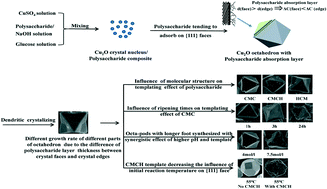Roles played by polysaccharides with different structures in biomimetic synthesis of cuprous oxide†
Abstract
In this study, several polysaccharide derivatives, carboxymethyl cellulose sodium (CMC), carboxymethyl chitin (CMCH) and sodium alginate (HCM), were introduced as the template in the preparation of Cu2O. Polysaccharides mainly serve as templates by selectively adsorbing onto the {111} faces of Cu2O crystals. The different adsorption thicknesses of the polysaccharide adsorption layers on the {111} surfaces and crystal corners of the Cu2O crystals cause Cu2O crystals to transform from octahedrons to octa-pods. The relative adsorption tightness (AC) of the three polysaccharides on the {111} planes of Cu2O crystals are AC(HCM) > AC(CMCH) > AC(CMC), which leads to intact Cu2O octa-pods, octa-pods with apex angles that are smaller plates or shallower pits, and octa-pods with apex angles that are depressed pits, respectively. In addition, to our knowledge, it is the first time that Cu2O octa-pods with jagged crystalline edges are obtained by using the CMC template and Ostwald ripening process. Selective adsorption of the polysaccharide template on the {111} plane of the Cu2O crystal can prevent the effect of external conditions, such as the initial reaction temperature, on {111} faces, which effects the morphology of the ultimate Cu2O crystal and favors the retention of the {111} surface. Polysaccharide adsorption layers with different thicknesses in different parts of the Cu2O crystal can be used to form Cu2O octa-pods with significantly increased foot lengths cooperating with a high concentration alkali solution.



 Please wait while we load your content...
Please wait while we load your content...